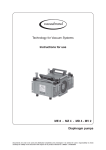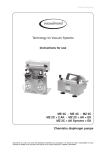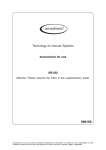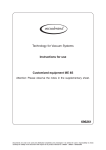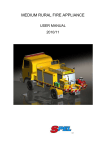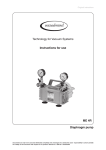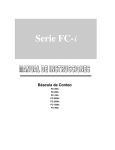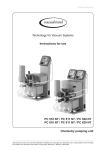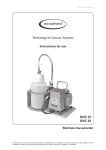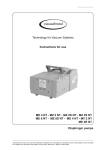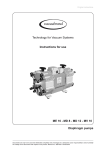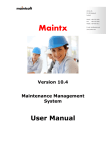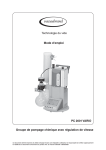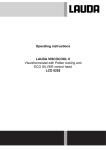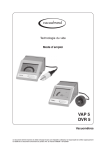Download - Vacuubrand.com
Transcript
page 1 of 41 Technology for Vacuum Systems Instructions for use MD 4 VARIO MV 2 VARIO MV 10 VARIO Diaphragm pumps with speed control Documents are only to be used and distributed completely and unchanged. It is strictly the users´ responsibility to check carefully the validity of this document with respect to his product. manual-no.: 999035 / 15/12/2009 page 2 of 41 Dear customer, Your VACUUBRAND diaphragm pump shall support you at your work for a long time without any trouble and with full load output. Thanks to our large practical experience we attained much information how you could add to an efficient application and to personal safety. Please read these instructions for use prior to the initial start-up of your pump. VACUUBRAND diaphragm pumps are the result of many years of experience in construction and practical operation of these pumps combined with the latest results in material and manufacturing technology. Our quality maxim is the ”zero fault principle”: Every delivered diaphragm pump is tested extensively including an endurance run of 18 hours. Due to this endurance run, also faults, which occur rarely, are reported an can be corrected. Every single diaphragm pump is tested on achievement of the specification after the endurance run. Every VACUUBRAND pump leaving our factory achieves the specification. We feel obliged to this high quality standard. We are aware that the vacuum pump should not draw a part of the real work and we hope to contribute with our products to an effective and troublefree realisation of your work. Yours VACUUBRAND GMBH + CO KG After sales service: Contact your local dealer or call +49 9342 808-193. Documents are only to be used and distributed completely and unchanged. It is strictly the users´ responsibility to check carefully the validity of this document with respect to his product. manual-no.: 999035 / 15/12/2009 page 3 of 41 Contents Safety information! .................................................................................................... 4 Technical data ............................................................................................................ 8 Description ..............................................................................................................12 Notes on operation .................................................................................................. 14 General view basic setups ......................................................................................16 How to configurate the controller ..........................................................................17 Basic setup TURBO•MODE .....................................................................................19 Basic setup pressure control ................................................................................. 21 Basic setup continuous pumping ..........................................................................23 Interface parameters ............................................................................................... 25 Read commands .....................................................................................................26 Write commands...................................................................................................... 27 Accessories .............................................................................................................28 Troubleshooting ...................................................................................................... 29 Readjustment .......................................................................................................... 31 Replacing diaphragms and valves ........................................................................ 32 Calibration in the factory .........................................................................................37 Notes on return to the factory ................................................................................ 38 Health and safety clearance form ..........................................................................39 Attention! Important notes! Not permitted! Misuse may cause damage. Caution! Hot surface! Isolate equipment from mains. Note. Documents are only to be used and distributed completely and unchanged. It is strictly the users´ responsibility to check carefully the validity of this document with respect to his product. manual-no.: 999035 / 15/12/2009 page 4 of 41 Safety information! Remove all packing material, remove the product from its packing-box, remove the protective covers from the inlet and outlet ports and keep, inspect the equipment. If the equipment is damaged, notify the supplier and the carrier in writing within three days; state the item number of the product together with the order number and the supplier’s invoice number. Retain all packing material for inspection. Do not use the equipment if it is damaged. If the equipment is not used immediately, replace the protective covers. Store the equipment in suitable conditions. ☞ Read and comply with this manual before installing or operating the equipment. ☞ Transport the pump at the provided handles. Use the equipment for the intended use only (for generation and measurement of vacuum). ☞ Prevent any part of the human body from coming in contact with the vacuum. ☞ Comply with notes on correct vacuum and electrical connections, see section ”Use and operation”. ☞ Make sure that the individual components are only connected, combined and operated according to their design and as indicated in the instructions for use. Comply with national safety regulations and safety requirements concerning the use of vacuum and electrical equipment. ☞ The mains switch for the controller and the pump is at the rear side of the controller. ☞ After switching off the pump , wait 60 sec. minimum until next switching on. ☞ Due to the high leakage current (up to 3.5 mA), a too low rated fault-current circuit breaker may be activated, especially if several pumps are operated parallelly. Attention: Make sure that a ground wire connection is established before the equipment is connected to mains supply! ➨ The pumps MD 4 VARIO, MV 2 VARIO and MV 10 VARIO are devices with doublepole cutoff and a symmetric capacitive circuit. ☞ If the leakage current is obtained by measuring the equivalent leakage current (according to VDE 0701, September 2000, section 5.7), the measured value may be divided by a factor of 2 in case the device is equipped with a double-pole cutoff and a symmetric capacitive circuit. ☞ The shock currents according to EN 61010 are below the limit of 3,5 mA. ☞ Equipment must be connected only to a suitable fused and protected electrical supply and a suitable earth point. Failure to connect the motor to ground may result in deadly electrical shock. ☞ The supply cable may be fitted with a moulded European IEC plug or a plug suitable for your local electrical supply. If the plug has been removed or has to be removed, the cable will contain wires colour coded as follows: green or green and yellow: earth; blue or white: neutral; brown or black: live. ☞ Check that mains voltage and current conform with the equipment (see rating plate). ☞ If the equipment is brought from cold environment into a room for operation, allow the equipment to warm up (pay attention to water condensation on cold surfaces). ☞ Pay attention to the max. permitted ambient temperature and make sure ventilation is adequate especially if pump is installed in a housing or if ambient temperature is elevated. ☞ Check fan (underside the pump) regularly for dust/dirt. Clean if necessary. Documents are only to be used and distributed completely and unchanged. It is strictly the users´ responsibility to check carefully the validity of this document with respect to his product. manual-no.: 999035 / 15/12/2009 page 5 of 41 Comply with all relevant safety requirements (regulations and guidelines) and adopt suitable safety measures. ☞ Provide a firm level platform for the equipment and check that the system to be evacuated is mechanically stable and that all fittings are secure. Attention: Flexible elements tend to shrink when evacuated. Due to the high compression ratio of the pumps, pressure at the outlet port might be generated being higher than the max. permitted pressure compatible with the mechanical stability of the system. Attention: Due to soiling of the silencer an internal overpressure may build up, which can damage bearings, diaphragms and valves. Make sure that the exhaust cannot become blocked. ☞ Comply with maximum permitted pressures and pressure differences, see section ”Technical data”. Do not operate the pump with overpressure at the inlet. Do not permit any uncontrolled pressurizing (e. g. make sure that the exhaust pipeline cannot become blocked). If you have an exhaust-isolation valve, make sure that you cannot operate the equipment with the valve closed. Risk of bursting! ☞ Ensure that the system design does not allow the exhaust pipeline to become blocked. ☞ Max. permitted pressure at the pressure transducer: 1.5 bar (absolute). ☞ Avoid overpressure of more than 0.2 bar in case inert gas is connected. ☞ The diameter of the inlet and outlet pipeline should be at the least as large as the diameter of the pump connection pipelines. To the best of our knowledge the equipment is in compliance with the requirements of the applicable EC-directives and harmonized standards (see ”Declaration of conformity”) with regard to design, type and model, especially directive IEC 1010. This directive gives in detail conditions, under which the equipment can be operated safely (see also IP degree of protection). ☞ Adopt suitable measures in case of differences, e. g. using the equipment outdoors, installation in altitudes of more than 1000 m above mean sea level, conductive pollution or dewiness. Pay attention to symbol ”hot surfaces” on the equipment (according to IEC 1010 recommendation). ☞ Adopt suitable measures to prevent any danger arising from the formation of hot surfaces or electric sparks. The pumps are not suitable to pump dangerous or explosive gases or explosive or flammable mixtures. Ensure that the materials of the wetted parts are compatible with the pumped substances, see section ”Technical data”. ☞ Adopt suitable measures to prevent the release of dangerous, explosive, corrosive or polluting fluids. ☞ Take adequate precautions to protect people from the effects of dangerous substances, wear appropriate safety-clothing. ☞ Comply with applicable regulations when disposing of chemicals. Take into consideration that chemicals may be polluted. ☞ Use inert gas for gas ballast if necessary. ☞ The user must take suitable precautions to prevent any formation of explosive mixtures in the expansion chamber. In case of a diaphragm crack, mechanically generated sparks, hot surfaces or static electricity may ignite these mixtures. Due to the residual leak rate of the equipment, there may be an exchange of gas, albeit extremely slight, between the environment and the vacuum system. ☞ Adopt suitable measures to prevent contamination of the pumped substances or the environment. Documents are only to be used and distributed completely and unchanged. It is strictly the users´ responsibility to check carefully the validity of this document with respect to his product. manual-no.: 999035 / 15/12/2009 page 6 of 41 The motor is shut down by a thermal cutout in the winding. ☞ Attention: Manual reset is necessary. Switch off the pump or isolate the equipment from mains. Wait approx. five minutes before restarting the pump. ☞ Attention: In case of supply voltage below 100V, the lock of the cutout might be restricted and the pump might restart on its own after sufficient cooling down. Take suitable precautions, if an automatic restart of the pump may lead to a critical dangerous situation. The controller is equipped with a short circuit proof transformer with an integrated overload protection (no fuses). The pump is equipped with a frequency converter which checks the electronic system of the converter and of the motor of the pump extensively. The motor is protected by an additional thermal cutout (see section ”Troubleshooting”). ☞ Failure of the pump (e. g. by power failure) or connected components, parts of the supply or change of parameters (e. g. increase of pressure) must not lead to a critical dangerous situation under any circumstances. Attention: If the controller is operated in the basic setup TURBO•MODE, the pump restarts automatically after a power failure. Ensure that no dangerous status of the system due to the automatic startup of the pump (e.g. after a power failure) can occur and provide appropriate safety measures. Electronic equipment is never 100% fail-safe. This may lead to an indefinite status of the equipment. Provide protective measures against misfunction and failure. ☞ Operating the pump with high or low frequency, stand still of the pump or operating an optional air admittance valve must not lead to a critical dangerous situation under any circumstances. Ensure that in case of failure the pump and the vacuum system always will turn into a safe status. ☞ In case of diaphragm cracks or leaks in the manifold pumped substances mighty be released into the environment or into the pump housing. To reduce the risk of leaks, ask for a diaphragm pump with additional safety diaphragm. ☞ Comply especially with notes on operation and use and maintenance. Use only genuine spare parts and accessories. ☞ Otherwise safety and performance of the equipment as well as the electromagnetic compatibility of the equipment might be reduced. Possibly the CE mark or the C/US conformity becomes void if not using genuine spare parts. The A-weighed emission sound pressure level of the pump does not exceed 70 dB(A). Measurement according to EN ISO 2151:2004 and EN ISO 3744:1995 with standard silencer or exhaust tube at outlet. Ensure that maintenance is done only by suitable trained and supervised technicians. Ensure that the maintenance technician is familiar with the safety procedures which relate to the product processed by the vacuum system and that the equipment, if necessary, is appropriately decontaminated before starting maintenance. Comply with local and national safety regulations. Wear parts have to be replaced regularly. In case of normal wear the lifetime of the diaphragms and valves is > 10000 operating hours. Bearings have a typical durability of 40000 h. ➨ Isolate equipment from mains and wait two minutes before starting maintenance to allow the capacitors to discharge. ➨ Before starting maintenance, wait two minutes after isolating the equipment from mains to allow the capacitors to discharge. Documents are only to be used and distributed completely and unchanged. It is strictly the users´ responsibility to check carefully the validity of this document with respect to his product. manual-no.: 999035 / 15/12/2009 page 7 of 41 ☞ Before starting maintenance vent the pump, isolate the pump and other components from the vacuum system and the electrical supply. Allow sufficient cooling of the pump. ☞ Ensure that the pump cannot be operated accidentally. Never operate the pump if covers or other parts of the pump are disassembled. Never operate a defective or damaged pump. ☞ Attention: The pump might be contaminated with process chemicals which have been pumped during operation. Ensure that the pump is decontaminated before maintenance and take adequate precautions to protect people from the effects of dangerous substances if contamination has occurred. Repair of the gauge head VSK 5 is not possible In order to comply with law (occupational, health and safety regulations, safety at work law and regulations for environmental protection) vacuum pumps, components and measuring instruments returned to the manufacturer can be repaired only when certain procedures (see section ”Notes on return to the factory”) are followed. Documents are only to be used and distributed completely and unchanged. It is strictly the users´ responsibility to check carefully the validity of this document with respect to his product. manual-no.: 999035 / 15/12/2009 page 8 of 41 Technical data Type Max. pumping speed* 50/60 Hz (DIN 28432) Ultimate vacuum* (absolute) Max. per missible outlet pressure (absolute) MD 4 VARIO MV 2 VARIO MV 10 VARIO m 3/ h 4,6 2,8 10,0 mbar 1** 0,3** 0,3** bar 1,1 1,1 1,1 Per missible ambient t e m p e ra t u r e s t o ra g e / o p e ra t i o n °C -10 to +60 / +10 to +40 Per missible relative atmospher ic moisture dur ing o p e ra t i o n ( n o c o n d e n s a t i o n ) % 30 to 85 M a x . p ow e r 100-120 V~ 50/60 Hz 230 V~ 50/60 Hz VA VA 420 575 1000 Typical power*** 100-120 V~ 50/60 Hz 230 V~ 50/60 Hz VA VA 150 230 230 No-load speed 50/60 Hz m i n -1 30 - 2400 Max. current 100-120 V~ 50/60 Hz 230 V~ 50/60 Hz A A 4,2 2,5 4,4 Typical operational current (at ultimate vacuum) 100-120 V~ 50/60 Hz 230 V~ 50/60 Hz A A 1,1 0,7 1,0 100-120 V~ +5/-10% 50/60 Hz 230 V~ +/-10% 50/60 Hz 230 V~ +/-10% 50/60 Hz Maximum per missible range of supply voltage**** Attention: Obser ve specifications of rating plate! ther mal cutout Motor protection D e gr e e o f p r o t e c t i o n I E C 5 2 9 IP 20 Inlet small flange NW 16 small flange NW 25 silencer silencer / hose nozzle NW 10 mm 345 x 235 x 235 486 x 245 x 325 kg 18,9 28 Outlet Dimensions L x W x H Weight approx. Technical data according to EN 61010-1 and EN 1012-2. The pump achieves its ultimate vacuum only in operation mode ”TURBO•MODE” with backing pressure ”Lo” at operating temperature (after approx. 15 min.). *** Depending on throughput and inlet pressure. **** VACUUBRAND pumps of type MV 10 VARIO are pumps for professional use at vacuum technical systems connected to low-voltage power supply systems of trade, research or industry. To connect the pumps to a public low-voltage power supply system, ask the competent power authorities for a connection permission or use an appropriate mains filter. * ** We reserve the right for technical modification without prior notice! Documents are only to be used and distributed completely and unchanged. It is strictly the users´ responsibility to check carefully the validity of this document with respect to his product. manual-no.: 999035 / 15/12/2009 page 9 of 41 C V C 2 0 0 0 II Controller exter nal, capacitive absolute pressure transducer made of aluminiumoxide ceramic P r e s s u r e t ra n s d u c e r Electronic scale conversion (selectable) mbar, Torr or hPa M e a s u r e m e n t ra n g e 1 mbar - 1100 mbar (1 Torr - 825 Torr) M a x . p r e s s u r e c o n t r o l ra n g e * 1 mbar - 1060 mbar (1 Torr - 795 Torr), or "LO" (<1 mbar, in TURBO MODE only). C o n t r o l ra n g e o f m o t o r s p e e d • 1,0 - 60,0 Hz at steps of 0 ,5 Hz or "HI" (max. 80 Hz) U n c e r t a i n t y ( w i t h t ra n s d u c e r c a r e f u l l y c a l i b ra t e d a n d a t c o n s t a n t t e m p e ra t u r e ) <+/-1 mbar (1 Torr) +/-1 digit Temperature coefficient <+/- 0,07 mbar/K (0,05 Torr/K) D e gr e e o f p r o t e c t i o n o f p r e s s u r e t ra n s d u c e r according to IEC 529 IP 54 Max. per mitted pressure at the pressure t ra n s d u c e r ( a b s o l u t e ) 1.5 bar (1125 Torr) M a x . p e r m i t t e d t e m p e ra t u r e o f g a s e o u s m e d i a for shor t per iods up to 80°C Ser ial interface * RS 232 C The actual pressure control range in your special application might be reduced due to ultimate vacuum of the pump, quantity of gas occurring etc. Components Wetted par ts Pump Housing cover / Head cover Aluminium alloy (AlSi12) O-r ing FPM D i a p h ra g m c l a m p i n g d i s c Aluminium alloy (AlSi12) D i a p h ra g m FPM Valve FPM Small flange Stainless steel Silencer PA, PE Hose PE Fitting A l u m i n i u m a n o d i ze d Seal r ing FPM VSK 5 Seal chemically resistant fluoroelastomer P r e s s u r e t ra n s d u c e r h o u s i n g PTFE duroplastic reinforced on stainless steel P r e s s u r e t ra n s d u c e r Aluminiumoxide ceramic Gas inlet temperatures: Permitted range of gas temperatures at inlet Operating condition Inlet pressure C o n t i nu o u s o p e ra t i o n > 100 mbar (high gas load) ➨ +10°C to +40°C C o n t i nu o u s o p e ra t i o n < 1 0 0 m b a r ( l ow g a s l o a d ) ➨ 0°C to +60°C S h o r t - t i m e o p e ra t i o n ( < 5 m i nu t e s ) < 1 0 0 m b a r ( l ow g a s l o a d ) ➨ -10°C to +80°C We reserve the right for technical modifications without prior notice! Documents are only to be used and distributed completely and unchanged. It is strictly the users´ responsibility to check carefully the validity of this document with respect to his product. manual-no.: 999035 / 15/12/2009 page 10 of 41 MD 4 VARIO rating plate handle inlet small flange NW 16 controller CVC 2000II outlet silencer pump MD 4 VARIO with frequency converter pressure transducer VSK 5 MV 2 VARIO rating plate handle inlet small flange NW 16 controller CVC 2000II outlet silencer pump MV 2 VARIO with frequency converter pressure transducer VSK 5 Documents are only to be used and distributed completely and unchanged. It is strictly the users´ responsibility to check carefully the validity of this document with respect to his product. manual-no.: 999035 / 15/12/2009 page 11 of 41 MV 10 VARIO handle pump MV 10 VARIO with frequency converter outlet rating plate controller CVC 2000II inlet small flange NW 25 pressure transducer VSK 5 Documents are only to be used and distributed completely and unchanged. It is strictly the users´ responsibility to check carefully the validity of this document with respect to his product. manual-no.: 999035 / 15/12/2009 page 12 of 41 Description The controller can be adapted to the specific application by choosing another basic setup than ”TURBO•MODE” (factory-set), see section ”General view basic setups”. The status of the controller respectively of the connected accessories is displayed by corresponding symbols on the LCD. After switching on the version of the software is displayed. Then the basic setup is displayed as well as the symbol “air admittance valve” (if the valve is preselected) together with ”CAL”. This is displayed until internal check and adjustment programs are finished (max. five seconds). General view display setups setup pressure control or continuous pumping controller in TURBO•MODE Pressure reading pump symbol air admittance valve remote operation warning (in combination with other symbols) process control active selectable pressure units Documents are only to be used and distributed completely and unchanged. It is strictly the users´ responsibility to check carefully the validity of this document with respect to his product. manual-no.: 999035 / 15/12/2009 page 13 of 41 keys • setting of speed • switching in programs • ”key ▲” or ”key ▼” • pressure setting (only pressure control) • adapting process pressure • ”key p▲” or ”key p▼” • operating air admittance valve (only if valve is connected and preselected) • start or stop of process control • confirmation of selected values or mode • special function (in combination with another key) rear side CVC 2000II female connector to connect the gauge head VSK 5 connection power supply frequency converter serial interface RS 232 C mains switch connection mains cable female connector to connect trip line frequency converter thread M8 for stand rod (included) female connector to connect an air admittance valve Documents are only to be used and distributed completely and unchanged. It is strictly the users´ responsibility to check carefully the validity of this document with respect to his product. manual-no.: 999035 / 15/12/2009 page 14 of 41 Notes on operation Installing in a vacuum system: ☞ Avoid throttling losses by using connecting pipes with large diameter and keep them as short as possible. ☞ Reduce the transmission of vibration and prevent loading due to rigid pipelines. Insert elastic hoses or flexible elements as couplings between the pump and rigid pipes. Attention: Flexible elements tend to shrink when evacuated. ☞ Use a suitable valve to isolate the pump from the vacuum system to allow the pump to warm up before condensable vapours are pumped or to clean the pump before it is switched off. ☞ Connect the exhaust to a suitable treatment plant to prevent the discharge of dangerous gases and vapours to the surrounding atmosphere. Use a catchpot to prevent the drainage of contaminated condensate back into the pump. ☞ Max. ambient temperature: 40 °C ☞ Make sure ventilation is adequate if pump is installed in a housing or if ambient temperature is elevated. Keep a distance of min. 20 cm between fans and ambient parts. ☞ If pump is installed in altitudes of more than 1000 m above mean sea level check compatibility with applicable safety requirements, e. g. IEC 60034 (motor may overheat due to insufficient cooling). Prior to use: ☞ When assembling, ensure vacuum-tightness. After assembly, check the complete system for leaks. ☞ Attention: Use the silencer only in case of small gas throughput. Check the silencer regularly for permeability! ☞ Check fan cover (MV 10 VARIO: underside pump motor) regularly for dust/dirt. Clean if necessary. ☞ If toxic media or media harmful to health are pumped, connect an exhaust pipeline at the outlet and/or dispose of the exhaust gases accordingly (hood). During operation: Do not start pump if pressure difference between inlet and outlet port exceeds max. 1 bar. Attempts to start pump at higher difference may cause blockade and damage of the motor. ☞ Check compatibility with max. permitted pressure at outlet and max. pressure difference between inlet and outlet ports. Due to the high compression ratio of the pumps, pressure at the outlet port might be generated being higher than the max. permitted pressure compatible with the mechanical stability of the system. The pump achieves its pumping speed, ultimate total vacuum and vapour pumping rate only at operating temperature (after approx. 15 minutes). ☞ Prevent internal condensation, transfer of liquids or dust. The diaphragm and valves will be damaged, if liquids are pumped in significant amounts. ☞ Let the pump run with gas ballast to reduce condensation of pumped substances (water vapour, solvents, ....) in the pump. Motor is shut down by a thermal cutout in the winding. ☞ Manual reset is necessary. Switch off the pump or isolate the equipment from mains. Wait approx. five minutes before restarting the pump. Identify cause of failure and eliminate. ☞ Attention: In case of supply voltage below 100V, the lock of the cutout might be restricted and the pump might restart on its own after sufficient cooling down. Take suitable precautions, if an automatic restart of the pump may lead to a critical dangerous situation. Documents are only to be used and distributed completely and unchanged. It is strictly the users´ responsibility to check carefully the validity of this document with respect to his product. manual-no.: 999035 / 15/12/2009 page 15 of 41 female connector to connect gauge head VSK 5 gauge head VSK 5 ➨ Connect the cable of the gauge head to the female connector at the rear side of the vacuum controller. ➨ Connect the gauge head to the vacuum system by using a small flange connection or a hose connection. ☞ The device is adjusted together with the gauge head at the factory. If the gauge head is replaced a readjustment is recommended. ➨ Connect cable from the frequency converter of the pump to the controller (rear side): trip line and power supply of the frequency converter. Max. permitted pressure at the pressure transducer: 1.5 bar (absolute). Attention: Risk of bursting! ☞ The display flashes at a pressure higher than 1100 mbar. ☞ Comply with max. permitted pressure. ☞ Inside a vacuum system where evaporation occurs, e. g. rotary evaporator, the vacuum is not uniform, e. g. a cold condenser acts as pump or the vacuum in the pipeline is lower than in the system. Therefore carefully choose position where to connect the gauge head. ☞ Condensate and deposits in the pressure transducer affect the measuring result. ☞ In case of deposits, aggressive or condensable media, install a gas washing bottle before the pressure transducer if necessary. ☞ In order to avoid malfunction it is important to position the pressure transducer in the vacuum line so as to avoid flow of condensate towards the pressure transducer. ☞ Clean pressure transducer if necessary, see section ”maintenance”. Shutdown: Short-term: Has the pump been exposed to condensate? ➨ Allow the pump to continue to run at atmospheric pressure for a few minutes (continuous pumping, setting ”HI”). Has the pump been exposed to media which may damage the pump materials or forms deposits? ➨ Check and clean pump heads if necessary. Long-term: ➨ Take measures as described in section short-term shutdown. ➨ Separate pump from the apparatus. ➨ Close inlet and outlet port (e. g. with transport caps). ➨ Store the pump in dry conditions. Documents are only to be used and distributed completely and unchanged. It is strictly the users´ responsibility to check carefully the validity of this document with respect to his product. manual-no.: 999035 / 15/12/2009 page 16 of 41 General view basic setups CVC 2000II setting pressure unit (mbar / Torr / hPa) setting basic setup basic setup ”TURBO•MODE” (factory set) controller controls - pump according to preset pressure value (backing pressure) - setting ”Lo”: minimum pressure with preselected gas flow - air admittance valve (optional) basic setup ”pressure control” controller controls - pump according to preset pressure value - air admittance valve (optional) basic setup ”continuous pumping” controller controls - pump according to preset pumping speed - setting ”Hi”: optimum pumping speed at every pressure - air admittance valve (optional) configuration of the air admittance valve if applicable ready to start Documents are only to be used and distributed completely and unchanged. It is strictly the users´ responsibility to check carefully the validity of this document with respect to his product. manual-no.: 999035 / 15/12/2009 page 17 of 41 How to configurate the controller The controller CVC 2000II can be adapted to the specific application by choosing the appropriate basic setup, TURBO•MODE, pressure control or continuous pumping with preset pumping speed: The components of the chemistry vacuum system (air admittance valve) have to be preset once only. The basic set up as from last operation and the preselected values (e. g. for pressure, speed) are stored. In case of similar operation conditions it is possible to start immediately, if the preselections are chosen appropriately. The vacuum controller CVC 2000II offers three basic setups depending on - the components which are connected to the system. - the specific user and/or process requirements. In all basic setups: ☞ If an air admittance valve has been connected and preselected: ☞ Key-driven venting or adjustment of the set point by venting if process control is active. TURBO•MODE ☞ The diaphragm pump is operated according to the preset pressure value (backing pressure). ☞ High pumping speed due to 80 Hz operation to reduce pumpdown time. ☞ To reduce motor speed during regular high and ultrahigh vacuum operation for additional extension of the lifetime of diaphragms and valves (only as much diaphragm strokes as necessary). ☞ Control algorithm to determine the motor speed to reach the best backing pressure/ultimate vacuum of the turbo molecular pump (backing pressure ”Lo”). Pressure control ☞ Position control on preset pressure value. ☞ The pumping speed is adapted to the occurring gas/vapour, so that the preset pressure value is kept constantly. ☞ Operating in equilibrium by continuous adaption of the controller, no abrupt switching of valves. Continuous pumping with preset pumping speed ☞ Simple suction, suck liquids by siphon, drying, sucking off excess, etc. ☞ Suction with regulated pumping speed. ☞ Pumping down until the ultimate vacuum of the pump is achieved (e. g. to dry a system). ☞ System controlled by an interface: temporally variable pumping speed to optimize the process conditions (e. g. to dry sensitive substances). ☞ Setting ”Hi”: Optimum pumping speed at every pressure, speed adapted automatically to provide always the maximal pumpage. Documents are only to be used and distributed completely and unchanged. It is strictly the users´ responsibility to check carefully the validity of this document with respect to his product. manual-no.: 999035 / 15/12/2009 page 18 of 41 Setting the basic setup MODE + (mains switch) Starting the program: ➨ Press key MODE while switching on the controller. ☞ The basic setup ”TURBO•MODE” (factory-set) is displayed on the LCD. To change the basic setup: ➨ Press key ▲ or ▼ until the symbol of the desired basic setup is displayed. ➨ Press key START/STOP to confirm the selected basic setup. TURBO•MODE pressure control continuous pumping ☞ The symbol of the air admittance valve is displayed and ”yes” or ”no”. ➨ Switching between ”yes” or ”no” is possible by pressing key ▲ or ▼. ➨ Confirm the selection ”yes” or ”no” by pressing key START/ STOP. The controller is ready to start. How to change the pressure units + p (mains switch) mbar Torr hPa Press key p▲ or p▼ during switching on. ☞ The pressure units are displayed, the pressure unit as from last operation is flashing. ➨ Press key p▲ or p▼ to change pressure unit. Press key START/STOP when controller displays the desired pressure unit to finish the operation mode. Documents are only to be used and distributed completely and unchanged. It is strictly the users´ responsibility to check carefully the validity of this document with respect to his product. manual-no.: 999035 / 15/12/2009 page 19 of 41 Basic setup TURBO•MODE After switching on The process control is not active, i. e. the controller is ready for vacuum control, but control operation has not been started. ☞ The basic setup as from last operation is reactivated (after first switching on ”TURBO•MODE” (factory-set) is displayed). ☞ The actual pressure is displayed. ☞ Values as from last operation are reactivated. ☞ Press key START/STOP to start process control. Starting and stopping the process control ➨ Starting process control: Press key START/STOP. ➨ Stopping process control: Press key START/STOP. START STOP ➨ Attention: If the controller is switched off during active process control (i.e. without stopping the process control beforehand by pressing key START/STOP), the pump starts immediately after switching on the controller without pressing any further key. This behaviour is to prevent unintentional venting of the vacuum system in case of short power failure. The user has to ensure that no dangerous status of the system due to the automatic startup of the pump can occur and to provide appropriate safety measures. Venting (only possible if an external air admittance valve is connected and configurated) VENT Ensure that the turbo molecular pump is vented according to the instructions for use of the manufacturer. Short venting: ➨ Press key VENT shortly (< 2 sec.). ☞ Pumping is interrupted, the process control is stopped. Venting the system: ➨ Press key VENT continuously (> 2 sec.) until symbol air admittance valve is displayed. ☞ Pumping is interrupted, the process control is stopped. ☞ Ventilation until pressure does not change any more, i. e. until atmospheric pressure is attained. ☞ Key STOP interrupts venting at any time. Attention: If pressurized inert gas is used install an overpressure relief valve. Ensure that high pressure is compatible with the mechanical stability of the system! Documents are only to be used and distributed completely and unchanged. It is strictly the users´ responsibility to check carefully the validity of this document with respect to his product. manual-no.: 999035 / 15/12/2009 page 20 of 41 Setting the process parameter p p ➨ Press p▲ or p▼. ☞ The backing pressure (factory set: ”Lo” ) is displayed. ☞ If ”Lo” is selected, an automatic control program is started to determine the optimum motor speed to reach the best ultimate vacuum of the diaphragm molecular pump. Changing the backing pressure: ➨ Press p▲ or p▼. ☞ Set p and the backing pressure are displayed for approx. 1s. ☞ With a second tip within one second or continuous pressing: ➨ Set the backing pressure by pressing key p▲ or p▼. ☞ The value for the backing pressure is stored as the new set point when the key is released. Note: If the diaphragm pump is used as backing pump of a turbo molecular pump, it is recommended to operate the diaphragm pump in basic mode ”TURBO•MODE” and setting ”Lo”. Documents are only to be used and distributed completely and unchanged. It is strictly the users´ responsibility to check carefully the validity of this document with respect to his product. manual-no.: 999035 / 15/12/2009 page 21 of 41 Basic setup pressure control After switching on The process control is not active, i. e. the controller is ready for vacuum control, but control operation has not been started. ☞ The basic setup as from last operation is reactivated (after first switching on “TURBO•MODE” (factory-set) is displayed). ☞ The actual pressure is displayed. ☞ Values as from last operation are reactivated. ☞ Press key START/STOP to start process control. Starting and stopping the process control ➨ Starting process control: Press key START/STOP. ➨ Stopping process control: Press key START/STOP. START STOP Venting (only possible if an external air admittance valve is connected and configurated) Short venting: ➨ Press key VENT shortly (< 2 sec.). ☞ Pumping is interrupted, the process control is stopped. VENT Venting the system: ➨ Press key VENT continuously (> 2 sec.) until symbol air admittance valve is displayed. ☞ Pumping is interrupted, the process control is stopped. Attention: If pressurized ☞ Ventilation until pressure does not change any more, i. e. inert gas is used install until atmospheric pressure is attained. an overpressure relief ☞ Key STOP interrupts venting at any time. valve. Ensure that high pressure is compatible with the mechanical stability of the system! Setting of the set point p p 267 mbar ➨ Setting the set point by using the keys p▲ or p▼ (factory set 100 mbar): ☞ To activate set mode: Press key shortly. “Set p“ appears. ☞ Short tips toggle p in steps of 1 mbar ☞ Continuous pressing activates ramp: Set-point changes with increasing speed. Documents are only to be used and distributed completely and unchanged. It is strictly the users´ responsibility to check carefully the validity of this document with respect to his product. manual-no.: 999035 / 15/12/2009 page 22 of 41 Adjusting of set point p during pressure control p 520mbar p 67mbar Adjusting the process pressure upwards ➨ Press key p▲. ☞ When the key is pressed shortly, the current pressure is displayed for one second. ☞ With a second tip within one second or continuous pressing: The air admittance valve is opened if connected or pressure increase due to system parameters, the current pressure is displayed. ☞ The achieved pressure is stored as new set point when the key is released. Adjusting the process pressure by pumping down: ➨ Press key p▼. ☞ When the key is pressed shortly, the current pressure is displayed for one second. ☞ With a second tip within one second or continuous pressing: Pumping down with preset speed, the actual pressure is displayed and stored as new set point p when the key is released. ☞ The achieved pressure is stored as new set point and adjusted automatically. Manual determination of the set point p 45.0 ➨ Setting the value for the speed by using key ▲ or ▼ (factory-set: ”HI”). ☞ To activate set mode: Press key shortly. The current speed is displayed for one second. ☞ With a second tip within one second or continuous pressing: ☞ Set speed. The new set point is stored when the key is released. To start process control: ➨ Start: Press key START and immediately key p▼. Keep key p▼ pressed. Pumping down starts with preselected speed. START STOP ☞ Supervise process permanently. When sufficient evaporation appears, release key p▼. ☞ The actual pressure is stored as new set point. ☞ Pressure control starts. p Temporary switching to setting continuous pumping ☞ Switching if process control is inactive: ➨ Keep key MODE pressed while pressing key ▲. MODE Documents are only to be used and distributed completely and unchanged. It is strictly the users´ responsibility to check carefully the validity of this document with respect to his product. manual-no.: 999035 / 15/12/2009 page 23 of 41 Basic setup continuous pumping After switching on The process control is not active, i. e. the controller is ready for vacuum control, but control operation has not been started. ☞ The basic setup as from last operation is reactivated (after first switching on ”TURBO•MODE” (factory-set) is displayed). ☞ The actual pressure is displayed. ☞ Values as from last operation are reactivated. ☞ Press key START/STOP to start process control. Starting and stopping the process control ➨ Starting process control: Press key START/STOP. ➨ Stopping process control: Press key START/STOP. START STOP Venting (only possible if an external air admittance valve is connected and configurated) Short venting: ➨ Press key VENT shortly (< 2 sec.). ☞ Pumping is interrupted, the process control is stopped. VENT Attention: If pressurized inert gas is used install an overpressure relief valve. Ensure that high pressure is compatible with the mechanical stability of the system! Venting the system: ➨ Press key VENT continuously (> 2 sec.) until symbol air admittance valve is displayed. ☞ Pumping is interrupted, the process control is stopped. ☞ Ventilation until pressure does not change any more, i. e. until atmospheric pressure is attained. ☞ Key STOP interrupts venting at any time. Setting the pumping speed 45.0 Setting of speed: Setting the value for the speed by using key ▲ or ▼: ☞ To activate set mode: Press key shortly. The current speed is displayed for one second. ☞ With a second tip within one second or continuous pressing: ☞ Set speed. The new set point is stored when the key is released. ☞ The speed setting ”HI” (above 60 Hz) enables pumping down as fast as possible to the best ultimate vacuum. Documents are only to be used and distributed completely and unchanged. It is strictly the users´ responsibility to check carefully the validity of this document with respect to his product. manual-no.: 999035 / 15/12/2009 page 24 of 41 Temporary switching to setting pressure control ☞ Switching to pressure control, if pumping down is activated (after pressing key START): ➨ Press key MODE. ☞ The actual pressure is stored as new set point, i.e. the controller keeps the pressure constant. MODE ☞ Switching if process control is inactive: ➨ Keep key MODE pressed while pressing key ▲. MODE Documents are only to be used and distributed completely and unchanged. It is strictly the users´ responsibility to check carefully the validity of this document with respect to his product. manual-no.: 999035 / 15/12/2009 page 25 of 41 Interface parameters The controller CVC 2000II is equipped with a serial interface at the rear side of the housing (RS 232C, ninepole Sub-D-plug). ☞ Respectively plug-into or remove the cable from the interface (cable RS 232C, nine-pole Sub-D) only if the equipment is switched off. ☞ The interface is not electrically isolated from the measuring circuit. ☞ For optimal electromagnetic compatibility assemble an interface filter (cat. no.: 63 82 35). The controller can be operated via serial interface. Measuring results, preselections and the status of the controller can be read at any time. Controlling via interface is only possible, if the remote operation mode has been preselected at the controller. During remote operation the controller can be operated only via interface, the keys at the controller have no function. Setting of the interface Setting of the interface parameters directly at the controller is described below. The factory set values are underlined. ➨ 1200, 2400, 4800 or 9600 BAUD ➨ 7 data bits odd, 7 data bits even, 8 data bits none, 8 data bits odd, 8 data bits even ➨ no Handshake, XON/XOFF Handshake, CTS/RTS Handshake ➨ remote on, remote off ➨ Startbit = 1, Stopbit = 1 During remote operation all keys are without function. Keep key ▲ pressed while switching on. ☞ The controller switches to the mode to configurate the interface. + (mains switch) Set Set Set Set Set b.96 d.8 BAUD-Rate is displayed. ➨ Press key ▲ or ▼ to select the BAUD rate and confirm with key START/STOP (”96”=9600, ”48”=4800, ”24”=2400, ”12”=1200). Data bits are displayed. ➨ Press key ▲ or ▼ to select the data bits and confirm with key START/STOP. P.no Parity is displayed. ➨ Press key ▲ or ▼ to select parity and confirm with key START/STOP (”no” = no check of parity, ”O” = odd, ”E” = even). h.no Handshake is displayed. ➨ Press key ▲ or ▼ to select handshake and confirm with key START/STOP (”no” = no Handshake, ”HA” = RTS/CTS, ”SO” = XON/XOFF). r.no Remote is displayed. ➨ Press key ▲ or ▼ to select local or remote operation and confirm with key START/STOP (”no” = local operation, ”On” = remote operation). ☞ The controller switches to normal operation mode (process control not active). Documents are only to be used and distributed completely and unchanged. It is strictly the users´ responsibility to check carefully the validity of this document with respect to his product. manual-no.: 999035 / 15/12/2009 page 26 of 41 Read commands Function Command Response Description actual pressure IN_PV_1 XXXX mbar or XXXX Torr or XXXX hPa unit according to preselections preset pressure (set point p) IN_SP_1 XXXX mbar or XXXX Torr or XXXX hPa unit according to preselections actual pumping speed IN_PV_2 XX.X Hz device set preselections IN_CFG X0X0X 0: remote operation off 1: remote operation on 0: no air admittance valve 1: air admittance valve 1: continuous pumping 2: pressure control 4: TURBO•MODE malfunction IN_ERR XXXX 1: last command to interface incorrect 1: malfunction pressure transducer 1: overpressure 1: fault frequency converter status of process control IN_STAT 0XXX 10: continuous pumping: inactive 11: active 20: pressure control: inactive 21: actual pressure > selected pressure 22: actual pressure = selected pressure (+/- 1mbar) 23: actual pressure < selected pressure 40: TURBO•MODE:inactive 41: actual pressure > selected pressure 42: actual pressure < /= selected pressure 0: air admittance valve not driven (closed) 1: air admittance valve driven (open) Documents are only to be used and distributed completely and unchanged. It is strictly the users´ responsibility to check carefully the validity of this document with respect to his product. manual-no.: 999035 / 15/12/2009 page 27 of 41 Write commands Function Command Parameter Description remote operation* REMOTE X 0: set controller to local operation 1: set controller to remote operation preset pressure (set point p) OUT_SP_1 XXXX unit according to preselection (0001 to 1060 mbar (hPa) or 0001 to 0795 Torr) (only setup TURBO•MODE: setting 0000 corresponds to ”Lo”) preset pressure OUT_SP_V (set point p) with venting** XXXX unit according to preselection (0001 to 1060 mbar (hPa) or 0001 to 0795 Torr) (only setup TURBO•MODE: setting 0000 corresponds to ”Lo”); only possible if process control is active selected pumping speed OUT_SP_2 XX.X Hz (01.0 to 60.0 in steps of 0.5 Hz) (setting 99.9 Hz corresponds to ”Hi”) operation mode OUT_MODE X 1: continuous pumping 2: pressure control 4: TURBO•MODE driving air admittance valve OUT_VENT X 0: close air admittance valve (not automatically) 1: open air admittance valve (process control stopped) starting process control START X 1: termination of process control 2: termination of process control and storage of the actual pressure as new set point stopping process control STOP * If remote operation is selected or deselected, the user has to ensure that no dangerous status of the system due to the change of the mode of operation can occur and to provide appropriate safety measures, especially if selecting remote operation interferes with a locally operated active process. ** Pressure setting with venting is only possible in operation mode ”Pressure control” if an air admittance valve is connected and configurated and pressure control is started. The air admittance valve opens automatically if the actual pressure is 10 mbar below the preset pressure. Automatic venting becomes inactive if pressure control is stopped (STOP or VENT), setting a pressure value using the command OUT_SP_1 or if the operation mode is changed. Activate the command OUT_SP_V again if necessary. The single abbreviations of a command are separated by underscores (ASCII 5FH). Command and parameter are separated by ignore characters (ASCII 20H). The string is terminated with <CR><LF> (ASCII 0DH, ASCII 0AH). Connector assignment 2: RxD 3: TxD 4: DTR 5: Mass 7: RTS 8: CTS Documents are only to be used and distributed completely and unchanged. It is strictly the users´ responsibility to check carefully the validity of this document with respect to his product. manual-no.: 999035 / 15/12/2009 page 28 of 41 Accessories Venting Venting valve VB M 24 V= ....................................... 66 68 17 Vacuum distribution The VACUU•LAN® modules allow process orientated, flexible and cost effective connections according to the requirements: One vacuum pump for multiple work stations. VCL 11 VCL 02 VACUU•LAN® manual flow control module VCL 01 ....................................................... 67 71 06 VCL 10 VCL 01 VACUU•LAN® shut off / manual flow control module VCL 02 ........................................................ 67 71 07 VACUU•LAN® automatic control module VCL 10 ........................................................ 67 71 08 VACUU•LAN® manual flow control/ automatic control module VCL 11 ......................... 67 71 09 On this page we offer only a small selection of VACUU•LAN® options. Please refer for further information. Documents are only to be used and distributed completely and unchanged. It is strictly the users´ responsibility to check carefully the validity of this document with respect to his product. manual-no.: 999035 / 15/12/2009 page 29 of 41 Troubleshooting Fault Possible cause R e m e dy No display. Î Mains not plugged in? ) Inser t mains plug, switch on. Check mains fuse in the building. Î Other cause (device defective)? ) Retur n the device to the factor y for repair. Display disappears, Î Ther mal over load, is inter nal over load protection a m b i e n t t e m p e ra t u r e t o o becomes actuated. high? ) Make sure ventilation is a d e q u a t e. Î Shor t circuit at the connected valves? ) Replace valves. Î Other cause (device defective)? ) Retur n the device to the factor y for repair. Î Adjustment has dr ifted off? ) Readjust the device. Î Moisture in the pressure t ra n s d u c e r ? ) Dr y, e.g. by pumping transducer, readjust, use g a s wa s h i n g b o t t l e i f necessar y. Î Deposits on the pressure t ra n s d u c e r ? ) S e e s e c t i o n m a i n t e n a n c e. Digital pressure display a n d wa r n i n g t r i a n g l e a r e flashing. Î Over pressure at the pressure transducer, pressure > 1100 mbar! ) Relieve pressure immediately (pressure transducer may suffer damage). Risk of bursting. Malfunktion indicator p r e s s u r e t ra n s d u c e r ( wa r n i n g t r i a n g l e a n d "Err"). Î Gauge head not connected? ) Connect gauge head to the female connector at the controller. Î P r e s s u r e t ra n s d u c e r defective? ) Use new gauge head. Î Controller is in remote o p e ra t i o n ( o n l y c o n t r o l l e d via the interface)? ) Switch off remote o p e r a t i o n i n c a s e, s e e section "interface". Pressure reading is incorrect. "PC" is displayed, all keys without function. War ning tr iangle and pump Î Fault at the frequency symbol are flashing. conver ter? ) Identify cause of failure (reset of the failure status is only possible by switching off the controller, before restar t wait 60s. Contact local distr ibutor if necessar y. Î Tr ip line and power supply to the frequency conver ter not connected? ) Check installation of the t r i p l i n e a n d p ow e r s u p p l y to the frequency conver ter. Î Motor over loaded? ) A l l ow t h e m o t o r t o c o o l d ow n , i d e n t i f y c a u s e o f failure. Then reset the controller by switching off. Î Over pressure in the outlet pipeline? ) Open outlet pipeline, make sure that the exhaust pipeline cannot become blocked. Î Power supply too small? ) Check power supply. Î Motor defective or blockade of the pump? ) Contact local distr ibutor. Documents are only to be used and distributed completely and unchanged. It is strictly the users´ responsibility to check carefully the validity of this document with respect to his product. manual-no.: 999035 / 15/12/2009 page 30 of 41 Fault Possible cause Controller does not react when operating keys. No change after switch off/on. R e m e dy ) Contact local distr ibutor. Pump fails to star t or stops immediately. Î Pump has been exposed to condensate? ) A l l ow t h e p u m p t o r u n w i t h inlet por t open for some minutes at max. frequency. Pump does not achieve ultimate vacuum or nor mal pumping speed. Î Incorrect settings at the controller? ) C h o o s e o p e ra t i o n m o d e c o n t i nu o u s p u m p i n g w i t h setting "HI" and check again. Î Centr ing r ing not correctly positioned or leak in the pipeline or vacuum system? ) Check pump with a vacuum gauge directly at pump inlet por t, check c o n n e c t i o n s a n d l i n e s. Î L o n g , n a r r ow l i n e ? ) Use line with larger diameter, length as shor t as possible. Î Pump has been exposed to condensate? ) A l l ow t h e p u m p t o r u n w i t h inlet por t open for some minutes at max. frequency. Î Deposits have been for med inside the pump? ) Clean and inspect pump h e a d s. Î Diaphragms or valves defective? ) R e p l a c e d i a p h ra g m s and/or valves. Î Outgasing substances or vapour generated in the process? ) Check process p a r a m e t e r s. Î Atmospher ic or high pressure at the inlet por t? ) Connect hose to pump outlet. Î D i a p h ra g m c l a m p i n g d i s c loose? ) Perfor m maintenance. Î None of above mentioned causes? ) Contact local distr ibutor. Pump to noisy. P u m p s e i ze d . ) Contact local distr ibutor. A service manual with exploded view drawing, spare part lists and directions for repair is available on request. ☞ The service manual is for trained service people. Documents are only to be used and distributed completely and unchanged. It is strictly the users´ responsibility to check carefully the validity of this document with respect to his product. manual-no.: 999035 / 15/12/2009 page 31 of 41 Readjustment The vacuum gauge was adjusted using factory standards, which are traceable through regular calibration in an accredited laboratory (German Calibration service) to the national standard. Depending on the process and/or accuracy requirements, check the adjustment and readjust if necessary. For readjustment, the device has to be adjusted both at atmospheric pressure as well as under vacuum. The adjustment mode can be activated only if the process control is inactive. Press key STOP if necessary. Adjustment at atmospheric pressure Ventilate the controller and/or the vacuum system. Make sure that the vacuum connection at the controller is at atmospheric pressure. ➨ Press key p▲ or p▼ simultaneously with key MODE, the + MODE controller then switches to the adjustment mode. p CAL ☞ The warning triangle and ”CAL” are displayed for approx. 2 seconds. ➨ While ”CAL” is displayed, press key START/STOP. ➨ Use key p▲ or p▼ to adjust the reading to the actual atmospheric pressure. ➨ Press key START/STOP to confirm. Note: To determine the actual atmospheric pressure, use an accurate barometer or get accurate reading from the weather service, the next airport.......(take into account the difference in altitude between e. g. airport and laboratory). Adjustment under vacuum Evacuate the controller to a pressure < 0.5 mbar (e. g. by applying a good rotary vane pump). ➨ Press key p▲ or p▼ simultaneously with key MODE, the controller then switches to the adjustment mode. + MODE ☞ The warning triangle and ”CAL” are displayed for approx. 2 p CAL seconds. ➨ While ”CAL” is displayed, press key START/STOP. ☞ The reading is automatically adjusted to ”zero”. ➨ Press key START/STOP to confirm. Note: Adjustment under vacuum with an actual pressure higher than 0.5 mbar reduces the accuracy of the measurement. If the pressure is significantly higher than 0.5 mbar, adjustment to a reference pressure is recommended. Adjustment at a reference pressure + MODE p CAL 0 .... 20 mbar p Instead of adjustment under vacuum to a pressure < 0.5 mbar, adjustment to a reference pressure within the range of 0 ..... 20 mbar is possible. ➨ Press key p▲ or p▼ simultaneously with key MODE, the controller then switches to the adjustment mode. ☞ The warning triangle and ”CAL” are displayed for approx. 2 seconds. ➨ While ”CAL” is displayed, press key START/STOP. ☞ The reading is automatically adjusted to ”zero”. ➨ Use keys p▲ or p▼ to adjust the display to the reference pressure at the vacuum line within the range of 0 ..... 20 mbar. ➨ Press key START/STOP to confirm. Note: The accuracy of the value of the reference pressure will directly affect the accuracy of the adjustment. If the nominal ultimate vacuum of a diaphragm pump is used as reference vacuum, the accuracy of the controller might be doubtful. The diaphragm pump may not achieve the specified value (due to condensate, poor state, failure of valves or the diaphragm). Documents are only to be used and distributed completely and unchanged. It is strictly the users´ responsibility to check carefully the validity of this document with respect to his product. manual-no.: 999035 / 15/12/2009 page 32 of 41 Replacing diaphragms and valves All bearings are encapsulated and are filled with long-life lubricant. Under normal operating conditions they are maintenance free. The valves and the diaphragms are wear parts. If the rated ultimate vacuum is no longer achieved or in case of increased noise level, the pump interior, the diaphragms and the valves must be cleaned and the diaphragms and valves must be checked for cracks or other damage. Depending on individual cases it may be efficient to check and clean the pump heads on a regular basis. In case of normal wear the lifetime of the diaphragms and valves is > 10000 operating hours. ☞ Prevent internal condensation, transfer of liquids or dust. The diaphragm and valves will be damaged, if liquids or dust are pumped in significant amount. If the pump is exposed to corrosive gases or vapours or in case of deposits, maintenance should be carried out more frequently. ☞ Regular maintenance will improve the lifetime of the pump and also protect both man and environment. Before starting maintenance vent the system, isolate the pump and other components from the vacuum system and the electrical supply. Drain condensate if applicable, avoid the release of pollutants. Allow sufficient cooling of the pump. Before starting maintenance, wait two minutes after isolating the equipment from mains to allow the capacitors to discharge. Ensure that the pump cannot be operated accidentally. Never operate the pump if covers or other parts of the pump are disassembled. Never operate a defective or damaged pump. Ensure that maintenance is done only by suitably trained and supervised technicians. Ensure that the maintenance technician is familiar with the safety procedures which relate to the products processed by the pumping system. The pump might be contaminated with the process chemicals that have been pumped during operation. Ensure that the pump is decontaminated before maintenance and take adequate precautions to protect people from the effects of dangerous substances if contamination has occurred. ☞ Wear appropriate safety-clothing when you come in contact with contaminated components. Set of seals (diaphragms, valves and seals) for MD 4 / MV 2 VARIO ...................................... 69 68 34 Set of seals (diaphragms, valves and seals) for MV 10 VARIO ............................................... 69 68 27 Face wrench with torque indicator ............................................................................................. 63 75 80 Tools: - Phillips screw driver size 2 Open-ended wrench w/f 17 Hex key size 5 Face wrench with torque indicator ☞ Please read section ”Replacing diaphragms and valves” completely before starting maintenance. Partially the pictures show pumps in other versions. This doesn´t influence replacing diaphragms and valves of the pump. Documents are only to be used and distributed completely and unchanged. It is strictly the users´ responsibility to check carefully the validity of this document with respect to his product. manual-no.: 999035 / 15/12/2009 page 33 of 41 Cleaning and inspecting the pump heads ➨ Use open-ended wrench, remove screw-in fittings from all pump heads. ➨ To check the valves use hex key to remove four sockethead screws from pump head and remove housing cover with head cover, valves and O-ring (MD 12 / MV 10 only). ☞ Never remove parts by using a spiky or sharp-edged tool (e.g. screw driver), we recommend to use a rubber mallet or compressed air (to be blown carefully into port). ➨ Remove head cover carefully from housing cover. Note position of valves and remove them. ☞ Replace valves if necessary. ☞ Use petroleum ether or industrial solvent to remove deposits. Do not inhale. View of the disassembled pump head parts (e. g. MV 10 VARIO) valve* cover plate* countersunk head screw* housing connecting rod washer diaphragm diaphragm support disc diaphragm clamping disc head cover seal valve housing cover * only MV 10 VARIO Documents are only to be used and distributed completely and unchanged. It is strictly the users´ responsibility to check carefully the validity of this document with respect to his product. manual-no.: 999035 / 15/12/2009 page 34 of 41 ☞ Check diaphragm for damage and replace if necessary. ➨ To do so use Phillips screw driver to remove four countersunk head screws and lift off housing plate together with fittings and manifold. ☞ Use petroleum ether or industrial solvent to remove deposits if necessary. Do not inhale. Notes regarding the assembling of the diaphragm The set of seals is designated for diaphragm pumps with different technical performance. Delivering pumps with square hole diaphragm starts in the second term of 2002, but not at the same time for all types of pumps. Replacing a diaphragm with round hole, use the delivered diaphragm completely. Replacing a diaphragm with square hole, remove the punched part in the centre of the diaphragm before assembling. + Replacing a diaphragm with square hole ➨ Use a face wrench to remove diaphragm support disc. Check for washers. Do not mix the washers from the different heads. Make sure that the original number is reassembled at the individual pump head. ☞ Smaller number of washers: The pump will not attain final vacuum. More washers: Clamping disc will hit head cover; noise or even blockade of the pump. Position new diaphragm between diaphragm clamping disc with square head screw and diaphragm support disc. ☞ Note: Double diaphragm. Documents are only to be used and distributed completely and unchanged. It is strictly the users´ responsibility to check carefully the validity of this document with respect to his product. manual-no.: 999035 / 15/12/2009 page 35 of 41 Use the face wrench with torque indicator to assemble diaphragm clamping disc, diaphragm and diaphragm support disc (and eventually washers) to the connecting rod. ☞ Make sure that the square head screw of the diaphragm clamping disc is correctly seated in the guide hole of the diaphragm support disc. Optimum torque for the diaphragm support disc: 6 Nm. ☞ The optimum torque is achieved if the pointer in the handle of the VACUUBRAND face wrench shows to the longer marking line. Assembling pump heads ➨ By turning excentric bushing (front of connecting rod), bring connecting rod into a position in which diaphragm is in contact with housing and centred with respect to bore. Reassemble in reverse order. ➨ Install head cover (with O-ring if applicable), valves and housing cover. ☞ Make sure that the valves are correctly seated: Valves at the outlet with round centred opening under valve, valves at the inlet with kidney-shaped opening beside valve. ➨ By turning excentric bushing, bring connecting rod into upper turning point position (Max. stroke of the rod). ☞ Pay attention that the diaphragm stays positioned centrally so that it will become clamped uniformly between housing and head cover. ➨ Screw in four socket head screws fixing housing cover crosswise (e. g. in the sequence ➀, ➁, ➂, ➃) first slightly, then tighten. ☞ Do not tighten until head cover is in contact with housing, torque 12 Nm. ➃ ➀ ➁ ➂ Individual performance check of a pump head By measuring the pressure at the inlet port of the individual head: Use a suitable vacuum gauge (e. g. DVR 2, cat. no.: 68 29 02), make sure that it is correctly calibrated, and measure the pressure at the inlet port. A vacuum of less than 110 mbar should be indicated. ☞ If the reading is higher, recheck the pump chamber and make sure that the valves and the diaphragms are correctly seated (diaphragms concentric with bore). Documents are only to be used and distributed completely and unchanged. It is strictly the users´ responsibility to check carefully the validity of this document with respect to his product. manual-no.: 999035 / 15/12/2009 page 36 of 41 Montage of the connecting hose ➨ Use open-ended wrench to assemble fittings with connection hoses to all pump heads. If the pump does not achieve the ultimate pressure: ☞ In case the diaphragms and valves have been replaced, a run-in period of several hours is required before the pump achieves its ultimate vacuum. If all pump heads achieve a vacuum below 110 mbar but pump does not achieve the ultimate total pressure: Check hose connectors between pump heads and manifolds for leaks. If necessary recheck pump chamber. Documents are only to be used and distributed completely and unchanged. It is strictly the users´ responsibility to check carefully the validity of this document with respect to his product. manual-no.: 999035 / 15/12/2009 page 37 of 41 Changing the valve at the outlet manifold (only MV 10 VARIO) ➨ Use open-ended wrench to remove the screw-in fitting, which runs directly to the cover plate of the outlet manifold, at the pump head. ➨ Unscrew the countersunk head screws at the cover plate of the manifold and remove cover plate. ➨ Note position of valve and remove. ☞ Check valve for damage and replace if necessary. Make sure that the valve is correctly seated. ➨ Reassemble cover plate. ➨ Use open-ended wrench to assemble fitting with connection hoses to the pump head. Cleaning the gauge head VSK 5 The gauge itself is maintenance-free. If the vacuum system is contaminated (oil, particles, etc.), contamination of the pressure transducer will influence the accuracy of measurement. Do not clean the pressure transducer using a spiky or hard tool! ➨ Fill the gauge head chamber with a solvent (e. g. benzene) and allow sufficient cleaning time. Observe all regulations concerning use and disposal of solvents! ➨ Drain the solvent and dispose of in accordance with regulations, repeat cleaning if necessary. ➨ Rinse the gauge head chamber several times with alcohol in order to remove all solvent residues. ➨ Allow the pressure transducer to dry. ➨ Readjust the pressure transducer if necessary. Calibration in the factory Control of measuring equipment The VACUUBRAND DKD calibration laboratory is accredited by the Physikalisch-Technische Bundesanstalt (PTB; German national institute for science and technology and the highest technical authority of the Federal Republic of Germany for the field of meteorology and certain sectors of safety engineering) for the measurable variable pressure in the pressure range from 10-3 mbar to 1000 mbar in accordance with the general criteria for the operation of testing laboratories defined in the DIN EN ISO/IEC 17025:2000 series of standards. Calibration in the VACUUBRAND calibration laboratory: - To meet the requirements of the DIN ISO 9000ff and 10012 series of standards regarding the calibration of inspection, measuring and test equipment at specified intervals. - To document that the vacuum gauges calibrated are traceable to national standards of the PTB. Documents are only to be used and distributed completely and unchanged. It is strictly the users´ responsibility to check carefully the validity of this document with respect to his product. manual-no.: 999035 / 15/12/2009 page 38 of 41 Notes on return to the factory Repair - return - DKD calibration Safety and health of our staff, laws and regulations regarding the handling of dangerous goods, occupational health and safety regulations and regulations regarding safe disposal of waste require that for all pumps and other products the “Health and safety clearance form“ must be send to our office duly completed and signed before any equipment is dispatched to our premises. Fax or post a completed copy of the health and safety clearance form to us in advance. The declaration must arrive before the equipment. Enclose a second completed copy with the product. If the equipment is contaminated you must notify the carrier. No repair / DKD calibration is possible unless the correctly completed form is returned. Inevitably, there will be a delay in processing the equipment if information is missing or if this procedure is not obeyed. If the product has come in contact with chemicals, radioactive substances or other substances dangerous to health or environment, the product must be decontaminated prior to sending it back to the factory. ☞ Return the product to us disassembled and cleaned and accompanied by a certificate verifying decontamination or ☞ Contact an industrial cleaning and decontamination service directly or ☞ Authorize us to send the product to an industrial cleaning facility at your expense. To expedite repair and to reduce costs, please enclose a detailed description of the problem and the product´s operating conditions with every product returned for repair. We submit quotations only on request and always at the customer´s expense. If an order is given, the costs incurred are offset from the costs for repair or from the purchase price, if the customer prefers to buy a new product instead of repairing the defective one. ☞ If you do not wish a repair on the basis of our quotation, the equipment might be returned to you disassembled and at your charge! In many cases, the components must be cleaned in the factory prior to repair. For cleaning we use an environmentally responsible water based process. Unfortunately the combined attack of elevated temperature, cleaning agent, ultrasonic treatment and mechanical stress (from pressurised water) may result in damage to the paint. Please mark in the health and safety clearance form if you wish a repaint at your expense just in case such a damage should occur. We also replace parts due to optical aspects upon your request. Before returning the equipment ensure that (if applicable): ☞ Oil has been drained and an adequate quantity of fresh oil has been filled in to protect against corrosion. ☞ Equipment has been cleaned and/or decontaminated. ☞ All inlet and outlet ports have been sealed. ☞ Equipment has been properly packed, if necessary, please order an original packaging (costs will be charged), marked as appropriate and the carrier has been notified. ☞ Ensure that the completed health and safety declaration is enclosed. We hope for your understanding for these measures, which are beyond our control. Scrapping and waste disposal: Dispose of the equipment and any components removed from it safely in accordance with all local and national safety and environmental requirements. Particular care must be taken with components and waste oil which have been contaminated with dangerous substances from the process. Do not incinerate fluoroelastomer seals and “O“ rings. ☞ You may authorize us to dispose of the equipment at your expense. Documents are only to be used and distributed completely and unchanged. It is strictly the users´ responsibility to check carefully the validity of this document with respect to his product. manual-no.: 999035 / 15/12/2009 page 39 of 41 Health and safety clearance form Declaration concerning safety, potential hazards and safe disposal of waste, e. g. used oil. Safety and health of our staff, laws and regulations regarding the handling of dangerous goods, occupational health and safety regulations, safety at work laws and regulations regarding safe disposal of waste, e. g. waste oil, require that for all pumps and other products this form must be sent to our office duly completed and signed before any equipment is dispatched to our premises. Products will not be accepted for any procedure and handling and repair / DKD calibration will not start before we have received this declaration. a) Fax or post a completed copy of this form to us in advance. The declaration must arrive before the equipment. Enclose a second, completed copy with the product. If the product is contaminated you must notify the carrier (GGVE, GGVS, RID, ADR). b) Inevitably, the repair process will be delayed considerably, if this information is missing or this procedure is not obeyed. We hope for your understanding for these measures which are beyond our control and that you will assist us in expediting the repair procedure. c) Make sure that you know all about the substances which have been in contact with the equipment and that all questions have been answered correctly and in detail. 1. Product (Model): ........................................ 2. Serial No.: .................................................. 3. List of substances in contact with the equipment or reaction products: 3.1 Chemical/substance name, chemical symbol: a) ................................................................... b) ................................................................... 5. Way of transport / carrier: ........................................................................................... Day of dispatch to VACUUBRAND: ........................................................................................... If the paint is damaged, we wish a repaint or a replacement of parts due to optical aspects at our expense (see ”Notes on return to the factory”): ❑ yes ❑ no c) ................................................................... d) ................................................................... 3.2 Important information and precautions, e. g. danger classification: a) ................................................................... b) ................................................................... c) ................................................................... d) ................................................................... 4. Declaration (please mark as applicable): ❑ 4.1 for non dangerous goods: We assure for the returned product that - neither toxic, corrosive, biologically active, explosive, radioactive nor contamination dangerous in any way has occurred. - the product is free of dangerous substances. - the oil or residues of pumped media have been drained. ❑ 4.2 for dangerous goods: © 2003 VACUUBRAND GMBH + CO KG Printed in Germany - The oil has been drained from the product. Important: Dispose of according to national regulations. - The interior of the product has been cleaned. - All inlet and outlet ports of the product have been sealed. - The product has been properly packed, if necessary, please order an original packaging (costs will be charged) and marked as appropriate. - The carrier has been informed about the hazardous nature of the goods (if applicable). We assure VACUUBRAND that we accept liability for any damage caused by providing incomplete or incorrect information and that we shall indemnify VACUUBRAND from any claims as regards damages from third parties. We are aware that as expressed in § 823 BGB (Public Law Code of Germany) we are directly liable for injuries or damages suffered by third parties, particularly VACUUBRAND employees occupied with handling/ repairing the product. Signature: ........................................................................... We assure for the returned product that - all substances, toxic, corrosive, biologically active, explosive, radioactive or dangerous in any way which have pumped or been in contact with the product are listed in 3.1, that the information is complete and that we have not withheld any information. - the product, in accordance with regulations, has been ❑ cleaned ❑ decontaminated ❑ sterilized. VACUUBRAND GMBH + CO KG -Technology for Vacuum Systems- We declare that the following measures where applicable - have been taken: Name (print): ...................................................................... Job title (print): ................................................................... Company´s seal: ............................................................... Date: ................................................................................... Alfred-Zippe-Str. 4 - 97877 Wertheim Tel.: +49 9342 808-0 - Fax: +49 9342 808-450 E-Mail: [email protected] Web: www.vacuubrand.com Documents are only to be used and distributed completely and unchanged. It is strictly the users´ responsibility to check carefully the validity of this document with respect to his product. manual-no.: 999035 / 15/12/2009 page 40 of 41 Konformitätserklärung Declaration of conformity Déclaration de conformité Membranpumpe / Diaphragm pump / Pompe à membrane MD 4 VARIO (230V; 683415, 683416, 683417) MV 2 VARIO (230V; 683410, 683411, 683412) MV 10 VARIO (230V; 710100, 710101, 710102) Hiermit erklären wir, dass das oben bezeichnete Gerät in Konzeption und Bauart sowie in der von uns in Verkehr gebrachten Ausführung den grundlegenden Anforderungen der zutreffenden, aufgeführten EURichtlinien entspricht. Bei einer mit uns nicht abgestimmten Änderung an dem Gerät verliert diese Erklärung ihre Gültigkeit. We herewith declare that the product designated above is in compliance with the basic requirements of the applicable EC-directives stated below with regard to design, type and model sold by us. This certificate ceases to be valid if the product is modified without the agreement of the manufacturer. Par la présente, nous déclarons que le dispositif désigné ci-dessus est conforme aux prescriptions de base des directives EU applicables et indiqués en ci que concerne conception, dessin et modèle vendu par nous-mêmes. Cette déclaration cesse d´être valable si des modifications sont apportées au dispositif sans notre autorisation préalable. Maschinenrichtlinie (mit Änderungen) / Machine directive (with supplements) / Directive Machines (avec des suppléments) 2006/42/EG Niederspannungsrichtlinie / Low-Voltage Directive / Directive Basse Tension 2006/95/EG Richtlinie Elektromagnetische Verträglichkeit / Electromagnetic Compatibility Directive / Directive Compatibilité Electromagnétique 2004/108/EG Angewandte Harmonisierte Normen / Harmonized Standards applied / Normes Harmonisées utilisées DIN EN 12100-2, DIN EN 61010-1, DIN EN 1012-2, DIN EN 61326-1 Managementsysteme / Management systems / Systèmes de Management EN ISO 9001, EN ISO 14001 (1997-2006) Wertheim, 15.12.2009 ............................ Ort, Datum / place, date / lieu, date ............................ (Dr. F. Gitmans) Geschäftsführer / Managing Director / Gérant VACUUBRAND GMBH + CO KG -Vakuumtechnik im System-Technology for Vacuum Systems-Technologie pour système à vide- ppa. ................................. (Dr. J. Dirscherl) Technischer Leiter / Technical Director / Directeur technique Alfred-Zippe-Str. 4 - 97877 Wertheim Tel.: +49 9342 808-0 - Fax: +49 9342 808-450 E-Mail: [email protected] Web: www.vacuubrand.com Documents are only to be used and distributed completely and unchanged. It is strictly the users´ responsibility to check carefully the validity of this document with respect to his product. manual-no.: 999035 / 15/12/2009 page 41 of 41 Disclaimer: Our technical literature is only intended to inform our customer. The validity of general empirical values and results obtained under test conditions for specific applications depend on a number of factors beyond our control. It is therefore strictly the users´ responsibility to very carefully check the validity of application to their specific requirements. No claims arising from the information provided in this literature will, consequently, be entertained. VACUUBRAND GMBH + CO KG -Technology for vacuum systems© 2009 VACUUBRAND GMBH + CO KG Printed in Germany Alfred-Zippe-Str. 4 - 97877 Wertheim Tel.: +49 9342 808-0 - Fax: +49 9342 808-450 E-Mail: [email protected] Web: www.vacuubrand.com Documents are only to be used and distributed completely and unchanged. It is strictly the users´ responsibility to check carefully the validity of this document with respect to his product. manual-no.: 999035 / 15/12/2009









































